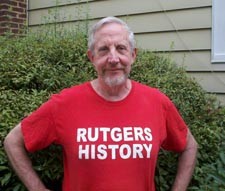Historian's new book uncovers an era that transformed the American criminal underworld

Prohibition, a period in which alcohol was banned from the United States, introduced an unprecedented and sophisticated criminal into 1920s America. In his latest historical narrative Prohibition Gangsters: The Rise and Fall of a Bad Generation (Rutgers University Press, June 2013), historian Marc Mappen explores the lives of these gangsters and their criminal activities within the context of the issues facing the nation.
Mappen, a former associate dean for academic affairs at Rutgers, is also the author of There’s More To New Jersey Than The Sopranos (Rutgers University Press 2009). His latest book, a featured book by the History Book Club and the Book of the Month Club, is the topic of a June 13 lecture at the Eagleton Institute of Politics. Rutgers Today talked with Mappen about Prohibition Gangsters, which uncovers an era that transformed the American criminal underworld.
Rutgers Today: What made you decide to write about the Prohibition gangsters? And what makes this topic important?
Marc Mappen: Growing up I read comic books and watched TV shows about the roaring ‘20s and the Prohibition era. But as I got older, I found few serious books that provided a collective biography of the gangsters from that period. So I decided to write a book that would try to separate myth from reality. Prohibition is an episode in American history like the Civil War, the Great Depression and the Cold War that deserves to be told.
Rutgers Today: What does this your book tell us about the history of United States?
Mappen: Prohibition turned liquor, a major American industry, over to the criminal underworld and gangsters of that era found themselves greatly admired for making booze available to the public. Before Prohibition, crime in America was not organized; small local gangs in cities made money by doing harm to the public via extortion, blackmail, loan sharking and burglary. But all that changed with Prohibition, which created large, complex criminal organizations that included truckers, lawyers, accountants, brew masters, chemists, warehousemen, bail bondsmen, bookies and other professionals.
Rutgers Today: With prohibition lasting close to 14 years, what impact did it have on the generation of men growing up in this era and after Prohibition ended?

Mappen: The men who became gangsters were almost all born between 1880 and 1905. They were mostly the sons of immigrants from Eastern and Southern Europe, who grew up in the ghettos of American cities like New York, Chicago and Boston. As is often the case with immigrants, entry into professional, white-collar jobs were closed off. When Prohibition came long, these men, mostly still in their 20s, found status and a career trajectory by building criminal organizations that didn’t simply go away when Prohibition ended.
Rutgers Today: Are there any connections between the Prohibition era and today’s war on drugs?
Mappen: I think the problems that the Federal government faced in the 1920s and today are similar: How can you prohibit a product that large numbers of the public want to buy? Drug trafficking existed in the Prohibition era too; many bootleggers also smuggled narcotics on the side. Pound for pound they made more from narcotics than liquor, but liquor was more widespread in American society, with saloons on every street corner and beer and wine served at home.
Rutgers Today: How accurate are shows like Boardwalk Empire in depicting what Prohibition really was like?
Mappen: TV shows, movies, comic books and other sources have conveyed a great deal about the Roaring ‘20s and beyond. But much of this folklore is dubious, or just plain wrong. For example, there is the myth that Eliot Ness, a Chicago-based prohibition agent, along with his “Untouchables” squad, single-handedly brought down Al Capone. Well, there was a real Eliot Ness, but the people who actually brought Capone to justice were Internal Revenue agents. As a matter of fact, trials for income tax evasion were the single most effective ways of putting major gangsters behind bars.
Another myth with a New Jersey perspective was that a huge gangster convention met in Atlantic City in May 1929. The convention supposedly involved dozens of mobsters from around the nation and set up a national crime syndicate. It now looks more likely that the Atlantic City meeting had only a few attendees, and they focused on cooling off the gang wars in Chicago.
Media Contact: Carla Cantor
732-932-9384, ext. 607
E-mail: ccantor@ur.rutgers.edu